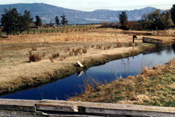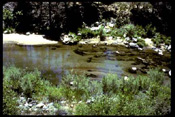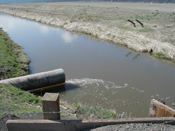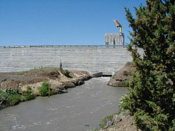TMDL
"The Total Maximum Daily Load (TMDL) process leads to a 'pollution budget' designed to restore the health of a polluted body of water. The TMDL process provides a quantitative assessment of water quality problems, contributing sources of pollution, and the pollutant load reductions or control actions needed to restore and protect the beneficial uses of an individual waterbody impaired from loading of a particular pollutant" (North Coast Regional Water Quality Control Board website).
The Clean Water Act driven TMDL plans currently being developed in the Klamath Basin represent a major opportunity for the improvement of water quality and cold water fish habitat. The recognized legal standing of TMDL plans (U.S. Court of Appeals Ninth Circuit, 2002. Pronsolino et al. vs. Nastri et al.) makes them important tools for the Tribes to use to reverse the decline of Pacific salmon and other important Klamath River fish species upon which they rely for subsistence.
Consortium members have provided comments on several Klamath Basin TMDLs to make sure that analysis was conducted using the currently recognized “best science.” They also urged speedy implementation guided by existing, scientifically sound restoration plans where they are available. While the Salmon River TMDL serves as an example of an excellent TMDL, the Shasta and Scott TMDLs reflect political compromise with lack of resolution of flow issues likely to confound pollution abatement efforts. The final Klamath River TMDL and Action Plan Addressing Temperature, Dissolved Oxygen, Nutrient, and Microcystin Impairments was released in June 2009 and public comments closed on August 27, 2009. To review the TMDL or to view the comment letters received, see the North Coast Water Board website.
Klamath River TMDL for Nutrients, Temperature and Dissolved Oxygen
The California Klamath River TMDLs are scheduled to be approved by the State Water Resources Control Board in December 2010. The final version is posted at the North Coast Water Board website. A public review draft of the Oregon Klamath River TMDL was circulated by the Oregon Department of Environmental Quality in February 2010 and is currently being finalized.
Below are links to the comments regarding Klamath TMDL submitted by the Tribes.
Yurok Tribe Environmental Program. 2010. Comments on the Oregon Department of Environmental Quality's Draft Upper Klamath and Lost River Subbasins Total Maximum Daily Load and Water Quality Management Plan. Submitted by Ken Fetcho, YTEP, Klamath, CA. 23 p.
Quartz Valley Indian Reservation. 2010. Comments on Draft Upper Klamath and Lost River Subbasins Total Maximum Daily Load and Water Quality Management Plan. QVIR, Ft. Jones, CA. 22p.
Yurok Tribe Environmental Program. 2010. Comments to the North Coast Regional Water Quality Board and U.S. EPA Re: revised text and substantive changes related to the Draft Klamath River TMDL. Submitted by Kathleen Sloan, YTEP, Klamath, CA. 19p.
Quartz Valley Indian Community. 2010 Comments on Public Review Draft, Staff Report for the Klamath River Total Maximum Daily Loads (TMDLs) and Action Plan Addressing Temperature, Dissolved Oxygen, Nutrient and Microcystin Impairments in California, the Proposed Site Specific Dissolved Oxygen Objectives for the Klamath River and California, and the Klamath River and Lost River Implementation Plans. Submitted by Crystal Bowman. QVIR, Ft. Jones, CA. 20 p. (Appendix A: Higgins comments Re: Fruit Growers Supply (FGS) Habitat Conservation Plan (HCP) and Draft Environmental Impact Report.) (Appendix B: Comments on State Water Resources Control Board Resolution 2009-0064 Regarding U.S. Forest Service Management Oversight.)
Karuk Tribe. 2009. Re: Comments on Public Review Draft and Staff Report for the Klamath River Total Maximum Daily Loads (TMDLs) and Action Plan Addressing Temperature, Dissolved Oxygen, Nutrient, and Microcystin Impairments in California. Submitted by Earl Crosby, Karuk Tribe, Orleans, CA, 37pp.
Quartz Valley Indian Community. 2009. Re: Comments on Public Review Draft and Staff Report for the Klamath River Total Maximum Daily Loads (TMDLs) and Action Plan Addressing Temperature, Dissolved Oxygen, Nutrient, and Microcystin Impairments in California. Submitted by Crystal Bowman. QVIR, Ft. Jones, CA. 39 p.
Yurok Tribe Environmental Program. 2009. Comments on Public Review Draft of Staff Report for the Klamath River Total Maximum Daily Loads (TMDLs) and Action Plan. Submitted by Ken Fetcho, YTEP, Klamath, CA. 37 pp.
Yurok Tribe Environmental Program (YTEP). 2009. Re: Comments on Review Draft Water Quality Restoration Plan for the Klamath River Basin in California: Draft Scoping for TMDL Implementation. Submitted by Ken Fetcho, YTEP, Klamath, CA. 26 p.
Quartz Valley Indian Community. 2006. Comments Concerning the Klamath River TMDL Approach and Progress to Date. Memo to the U.S. EPA and North Coast Regional Water Quality Control Board of August 15, 2006. Quartz Valley Indian Reservation, Fort Jones, CA. 35 p.
Quartz Valley Indian Community. 2007. Comments on Klamath River Nutrient, Dissolved Oxygen, and Temperature TMDL Implementation Plan Workplan Outline for CA (NCRWQCB, 2007). Quartz Valley Indian Community, Fort Jones, CA. 30 pp.
Summary of comments:
- The adult salmon kill in the September 2002, chronic high mortality of juvenile salmon and discovery of problems with toxic algae in Klamath Hydroelectric Project (KHP) reservoirs all point to a water quality crisis.
- Tribes are hopeful that the mainstem Klamath TMDL can be successfully avert a potential collapse of the Klamath River salmon stocks by spurring action to abate water pollution in the time frame needed for recovery.
- In the Upper Klamath Basin, including the Keno reach, the Lost River and short-nose suckers are similarly imperiled and are indicators of whether water quality is being restored and TMDL implementation is working.
- In order for the mainstem Klamath TMDL to succeed in abating pollution, other TMDLs (i.e. Upper Klamath Lake and Lower Lost River) must also succeed.
- The final Klamath TMDL should recommend the removal of the Klamath Hydroelectric Project dams, given their role in thermal and nutrient pollution of the river.
- Middle Klamath tributaries currently serve as critical coldwater refugia and the final Klamath TMDL must ensure their protection and restoration.
Shasta River TMDL for Temperature and Dissolved Oxygen
Status: The Shasta TMDL was approved by the North Coast Regional Water Quality Control Board (NCRWQCB) on June 29, 2006, the California State Water Resources Control Board (SWRCB) on November 15, 2006 and the U.S. Environmental Protection Agency (EPA) on January 26, 2007.
Quartz Valley Indian Community. 2006. Review of public draft Shasta River Temperature and Dissolved Oxygen TMDLs. Quartz Valley Indian Reservation, Ft. Jones, CA.
- The TMDL reaches the scientifically supported conclusion that increasing flows is an important action needed to remediate water temperature problems.
- Final Shasta TMDL included recommendation for increasing flows by 45 cubic feet per second (cfs) from May to October to remediate temperature problems.
- Model use in Shasta TMDL is valid and its assumptions were mostly well supported.
- Shasta TMDL model should have included pH, which exceeds Basin Plan standards, and nitrogen (in all forms, not just ammonia nitrogen and organic nitrogen) should have been measured and modeled because of its role in stimulating aquatic plant growth.
- TMDL considers Shasta River as a 40 mile trunk without functional tributaries and there is no mention of restoring connectivity despite historic flow data showing that all tributaries had perennial surface flow.
- Pollution from reaches of streams like upper Parks Creek are not recognized in the TMDL because they are not part of the model, even though Parks Creek is connected to the Shasta River during major storms.
- Shasta TMDL recognizes water quality problems in Dwinnell Reservoir that contribute to Shasta River water pollution, but does not discuss removing the dam as a means of abating the problem
- Removal of Dwinnell Dam will likely be necessary for abatement of water quality recovery and salmon restoration.
A major impediment to Shasta TMDL implementation is the lack of follow through by the CA SWRCB on getting flows increased. Their resolution adopting the Shasta TMDL had the following qualification:
“The Shasta TMDL does not require a water right proceeding to implement the temperature reductions and is explicit that the 45 cfs goal or alternative flow regime is not binding in any water right proceeding—should there ever be one.”
See also comments on the Shasta TMDL from conservation groups.
Scott River TMDL for Sediment and Temperature
Status: The Scott River TMDL was approved by the NCRWCB on December 15, 2005, by the CA SWRCB on June 21, 2006 and the U.S. EPA on September 8, 2006.
Quartz Valley Indian Community. 2005. Comments on Staff Report for the Action Plan
for the Scott River Watershed Sediment and Temperature Total Maximum Daily Loads (Scott TMDL). Quartz Valley Indian Reservation, Ft. Jones, CA. 64 p.
- The cumulative effects of timber harvest and related roads, which include increased flood flows, channel widening and depletion of large wood in stream are not addressed.
- Cumulative watershed effects are likely to confound efforts to abate sediment and temperature pollution.
- The upslope and instream monitoring measures proposed will neither support adaptive management nor will they provide an adequate basis from which to determine whether new Waste Discharge Requirement (WDR) permits or waivers are warranted, or whether existing permits and waivers should be continued.
- Groundwater and flow studies are assigned to the County of Siskiyou, rather than to a more impartial office like the SWRCB Water Rights Division. This assignment is inappropriate and it will likely slow the implementation of necessary water quality improvement measures.
- Neither the current collapse of the Scott River fall chinook salmon population nor the clear indications that the basin’s coho salmon population are at a high risk of extinction are acknowledged, nor are the recovery actions proposed sufficiently timely.
- The Implementation Work Plan fails to address the need to protect the coldwater refugia needed for salmon survival until the mainstem Scott River water temperature problems can be remedied.
Although the Scott TMDL Implementation Plan has been adopted, there are some concerns about progress. The memo cited below outlines those concerns.
Quartz Valley Indian Community. 2009. Memo on Scott River TMDL Implementation. From QVIR Environmental Director Crystal Bowman to Catherine Kuhlman, NCRWQCB Executive Director of May 13, 2009. Quartz Valley Indian Reservation, Ft. Jones, CA. 3 p. Photos (Appendix A).
Read comments on the Scott TMDL from conservation groups.
Lower Lost River TMDL for Nutrients and Temperature
Status: A Draft Lower Lost River TMDL was released in March 2007, but it had such significant flaws and is in revision. Through an extension agreement with parties to the Consent Decree and the Ninth Circuit Court Judge enforcing the TMDL timeline, agencies have been given additional time to complete the Lower Lost River TMDL and make sure it is compatible with the upcoming mainstem Klamath River TMDL.
Yurok Tribe 2007. Yurok Tribe comments on Lost River TMDL. Letter dated July 3, 2007, from Kevin McKernan of Yurok Tribe Environmental Program to Gail Louis of U.S. EPA. Yurok Tribe, Klamath, CA. 34 pp.
Karuk Tribe of California. 2007. Comments from the Karuk Tribe of California regarding the Lost River Total Maximum Daily Load. Letter dated July 2, 2007, from Sandy Tripp Karuk Tribe of California Department of Natural Resources to Gail Louis of U.S. EPA. Yurok Tribe, Klamath, CA. 34 pp.
- The March 2007 Draft Lower Lost TMDL showed a near-total failure to use existing water quality field data from the Lower Lost River sub-basin
- The model used for supporting the technical TMDL suffered from unmet assumptions and uncertainties, and did not incorporate important processes such as nitrogen fixation by blue-green algae, ground water influence, and natural riverine denitrification.
- The Draft TMDL failed to recognize the need to restore ecosystem function to reduce nutrient pollution (i.e. restoring riparian areas, wetlands and lakes).
- It also failed to define the steps needed to restore ESA-listed sucker species (i.e. no clear monitoring recommendations, no timetable for species recovery).
- Failed to recognize the present impacts of Lost River water quality on the Klamath River downstream or to determine the amount by which nutrients from the Lost River and Straits Drain must be reduced to prevent degradation of Klamath River water quality.
- The Draft TMDL recommended a special interest group, the Klamath Basin Water Users, to serve as technical lead for implementation while, at the same time, ignoring totally the existence and legitimate interest of the Tribes and other river protection interested communities.
Upper Lost River TMDL for Nutrients and Temperature
Status: NCRWQCB found no proof of nutrient or temperature impairment and removed the Upper Lost River from the impaired water bodies list.
Resighini Rancheria. 2004. Memo re: Total Maximum Daily Load (TMDL) analysis for, and the proposed de-listing of the Upper Lost River from California's 303(d) list. From Chairman Frank Down to Catherine Kuhlman, NCRWQCB Executive Director. Resighini Rancheria, Klamath, CA. 9 p.
- Agree that Upper Lost River TMDL is sound and that conclusions based on available data are warranted.
- Call for additional collection of data in tributaries to Clear Lake.
- NCRWQCB staff need to work with Modoc National Forest to further reform grazing in order to improve conditions for the major populations of shortnose and Lost River suckers that spawn above Clear Lake.
- Grazing on the shores of Clear Lake in a National Wildlife Refuge should be discontinued.
- NCRWQCB should list the Upper Lost River for turbidity, given the findings of high values discovered through field data collection.
Salmon River TMDL for Temperature
Status: The Salmon River Temperature TMDL was accepted by the NCRWQCB on June 22, 2005; the CA SWRCB on October 25, 2005; and by the U.S. EPA on March 29, 2006.
- The Salmon River TMDL includes guidance for implementation following the Salmon River Sub-basin Restoration Strategy, an existing plan from the U.S. Forest Service and Salmon River Restoration Council, however, funding for needed actions has not yet increased.
- This TMDL is not specific enough on monitoring necessary for effective adaptive management.
- The Memorandum of Understanding (MOU) between the NCRWQCB and the Klamath National Forest, in addition to the targets and guidelines established through management plans and watershed analyses, provide some level of assurance that appropriate actions will be taken.
- Risk of damaging increased peak flows is not addressed, which could potentially confound the success of Salmon River TMDL implementation.
- The TMDL does not adequately identify or discuss the significance of the Salmon River aquatic resources to the larger ecological context in the Klamath Basin (i.e. spring chinook in the basin and Klamath-wide species recovery).
Read comments from the Klamath Basin Coalition.







